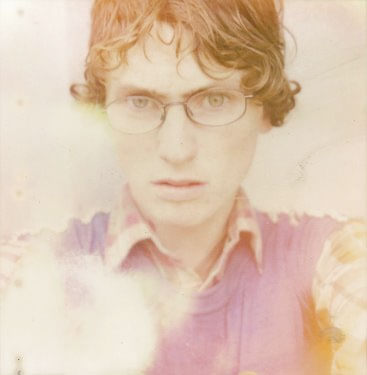Claiming inspiration from “old-school American values mixed with a little punk-rock idealism,” Mike Brodie, aka The Polaroid Kidd, hopped trains across the U.S. for seven years, documenting his friends, lovers, and travels with a Polaroid and a 35-millimeter camera and amassing a critically acclaimed body of images. Like a 21st-century Jack Kerouac, replacing pen with pictures, Brodie rode the railways with a motley crew. In 2004, two years into his journeying, he acquired a camera and began photographing this gritty youth subculture. His intimate portraits, saturated with color and often set against moving backgrounds, capture the reality of this life in raw detail—its dirt-encrusted bodies, sickness and exhilaration, dangers and comforts. After traveling more than 50,000 miles through 46 states, Brodie has since become an itinerant mechanic. He says he has abandoned photography—at least for now.
Source: Artsy
Mike Brodie, best known by his pseudonym "Polaroid Kidd", is a self-trained American photographer from Pensacola, Florida.
In 2003 Brodie left home at 18 to travel the rails across America. A friend gave him a camera and he found himself spending three years photographing the friends and companions he encountered with the Polaroid SX-70. Polaroid discontinued SX-70 film, so now he shoots on 35mm on a Nikon F3. His photographs have been featured in exhibits in Milwaukee, at Get This! Gallery in Atlanta and in Los Angeles at M+B Gallery. His work was also selected to appear in the 2006 edition of the Paris International Photo Fair at the Louvre.
In November 2007 he collaborated with Swoon and Chris Stain to mount an installation at Gallery LJ Beaubourg in Paris. He also has had collaborative shows with artist Monica Canilao. His photographs largely depict what he refers to as "travel culture", train-hoppers, vagabonds, squatters and hobos. Critic Vince Aletti of artsandantiques.net says of Brodie's work: "Even if you're not intrigued by Brodie’s ragtag bohemian cohort—a band of outsiders with an unerring sense of post-punk style—the intimate size and warm, slightly faded color of his prints are seductive. His portraits... have a tender incisiveness that is rare at any age."
Source: Wikipedia
Born in 1985, Mike Brodie began photographing when he was given a Polaroid camera in 2004. Working under the moniker 'The Polaroid Kidd,' Brodie spent the next four years circumambulating the United States, amassing an archive of photographs that make up one of the few, true collections of American travel photography. Brodie made work in the tradition of photographers like Robert Frank, William Eggleston and Stephen Shore, but due to never having undergone any formal training he always remained untethered to the pressures and expectations of art market.
Brodie compulsively documented his exploration of the tumultuous world of transient subcultures without regard to how the photographs would exist beyond him. After feeling as though he documented all that he could of his subject, his insatiable wanderlust found a new passion, and as quickly as he began making photographs, he has left the medium to continue in his constant pursuit of new adventures.
In 2008, Brodie received the Baum Award for American Emerging Artists and has a forthcoming book to be published by Steidl, as well as numerous international shows. Brodie recently graduated from the Nashville Auto Diesel College (NADC) and is now working as a diesel mechanic. Although Brodie has stopped making photographs, the body of work he made in only four short years has left a huge impact on the photo world, and is now being made available to the public.
Source: M+B
